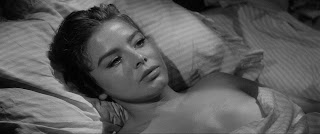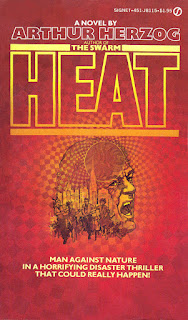THE DAY THE EARTH CAUGHT FIRE
Directed by Val Guest. Written by Wolf Mankowitz & Val Guest
Starring Janet Munro, Leo McKern, Edward Judd, Michael Goodlife, Bernard Braden.
1961, 100 minutes, B&W, Not Rated, 2.35:1
Directed by Val Guest. Written by Wolf Mankowitz & Val Guest
Starring Janet Munro, Leo McKern, Edward Judd, Michael Goodlife, Bernard Braden.
1961, 100 minutes, B&W, Not Rated, 2.35:1
Synopsis: London is experiencing a heat wave. As the story opens we are introduced to several characters: Peter Stenning (Edward Judd), young newspaperman who doesn't want to do anything but drink, Bill Maguire (Leo McKern), crusty old newspaperman with a heart of gold, and Jeannie Craig (Janet Munro), a young office worker at the London office of Meteorological Services. Stenning meets Craig while investigating whether sunspots could be causing the heat wave. It turns out not to be sunspots but instead a problem with the Earth's orbit. Both the U.S. and Russia inadvertantly set up huge atomic bombs at the same time at opposite ends of the Earth, and the resulting blasts rocked the Earth out of it's orbit and slowly moving towards the Sun. Soon the Heatwave produces a heat mist four stories high, then drought. With the heat rising each day, how long can mankind survive?
Note: Spoilers are contained herein. You have been warned.
By focusing on the few characters we meet rather than the overall global story we get a "you are there" effect that helps sells the story. This approach was also used to great effect by John Wyndham in The Day of the Triffids (1951) and by J.G. Ballard in his wonderful trilogy of disaster novels, The Wind From Nowhere (1961), The Drowned World (1962) and The Burning World (1963). The realism is this case largely comes from the newsroom setting. Set design, dialog, and direction are all pitch perfect to create a wholly believable environment where the characters act and react to the more fantastical elements of the story in an utterly non-melodramatic fashion. Additionally, the characters are presented in an adult, sophisticated manner. The treatment of sexuality is particularly notable, in that it still feels realistic more than fifty years later. The two leads are attracted to each other and there is no beating about the bush when then get together. Janet Munro spends much of the latter half of the movie in skimpier and skimpier outfits, which may not add to the realistic atmosphere, but is nice nonetheless1.
The film is not packed with visual effects, but the few effects are handled deftly. They mostly consist of matte paintings but are quite effective in context. The lack of global overview also affords more time to highlight the impact that such a situation would have on "normal" people. For instance, as the temperature continues to rise water becomes more scarce so rationing is implemented. Scenes of people waiting with empty cans for hours are depicted, as well as the inevitable human response to such a situation, namely looting and crime. These scenes are small scale but effective. It's only in the final minutes where the film feels a little more opened up.
Edward Judd gets an "and Introducing" credit but I'm not sure why--he was clearly in films before this one, but perhaps not as the lead. He spent most of his career in television. Other notable genre films that he appeared in were THE FIRST MEN IN THE MOON (1964), ISLAND OF TERROR (1966) and VENGEANCE OF SHE (1968). He's very good in this film, but merely okay in the others mentioned. Janet Munro had appeared in a number of Disney films in the late 50's and early 60's including DARBY O'GILL AND THE LITTLE PEOPLE (1959) and THE SWISS FAMILY ROBINSON (1960). She also appeared in THE CRAWLING EYE (1958). I haven't seen her in many films beyond the one's mentioned, but she is very good in this film. Leo McKern had a long career as a character actor, appearing in such things as The Prisoner (1967-1968) television show (as number two!), RYAN'S DAUGHTER (1970), THE OMEN (1976), THE BLUE LAGOON (1980), and THE FRENCH LIEUTENANT'S WOMAN (1981).
It was novelized by Barry Wells. Clearly working from the final shooting script it matches the action of the film exactly, but the author is able to create backstories for the lead characters that are believable. He also better explains how things work in a newsroom of this era, which goes a long way to enhancing the setting. He also can be more explicit in the love scenes, which is always appreciated. Where the book differs from the film is in the ending. As discussed above, the movie ends with the fate of the world unresolved. Nuclear bombs have been set off to try and correct the orbit of the Earth but we don't learn if it has worked or not. The novelization clearly states that the bombs have worked and that things will be going back to normal. It cannot be overstated how much this "happy" ending does not work for this story.
Arthur Herzog's novel Heat from 1977 also deals with the Earth out of orbital alignment. In fact, it shares the basic plot of THE DAY THE EARTH CAUGHT FIRE right down to the inconclusive ending, but is ultimately more similar to a traditional disaster film such as THE DAY AFTER TOMORROW. For instance, there is a single government employee who is given data that he believes signals the beginning of the end. Of course bureaucracy being what it is he encounters skepticism and roadblocks until it is almost too late.
1. I feel it my duty to mention that there is a brief topless scene by Ms. Munro. I only mention it because the liner notes go out of their way to claim that the scene doesn't exist in the movie! There are stills of a more obviously topless Munro floating around the Internet but there is nothing like that in the film. However, when she is bent over the sink washing her hair her breasts are definitely visible in the mirror.







